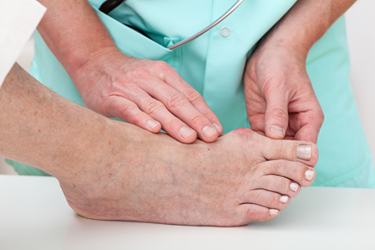 A bunion is described as a bony protrusion on the side of the big toe. It can develop as a result of genetic factors, or wearing shoes that do not have adequate room for the toes to move freely in. It is considered to be a bone deformity, and patients who have severe bunions may choose surgery as an option for permanent removal. The symptoms that are often associated with this condition can include pain in the joints of the big toe, calluses that form on top of the toe, and a shifting of the big toe toward the other toes. It may be difficult to wear shoes, in addition to having pain while walking or running. There are measures that can be implemented which may prevent bunions from developing. These include wearing shoes that fit properly, performing gentle foot stretches, or wearing shoe inserts that have adequate arch support. If you have developed a bunion, it is suggested that you speak with a podiatrist who can properly treat this condition.
A bunion is described as a bony protrusion on the side of the big toe. It can develop as a result of genetic factors, or wearing shoes that do not have adequate room for the toes to move freely in. It is considered to be a bone deformity, and patients who have severe bunions may choose surgery as an option for permanent removal. The symptoms that are often associated with this condition can include pain in the joints of the big toe, calluses that form on top of the toe, and a shifting of the big toe toward the other toes. It may be difficult to wear shoes, in addition to having pain while walking or running. There are measures that can be implemented which may prevent bunions from developing. These include wearing shoes that fit properly, performing gentle foot stretches, or wearing shoe inserts that have adequate arch support. If you have developed a bunion, it is suggested that you speak with a podiatrist who can properly treat this condition.
If you are suffering from bunion pain, contact our podiatrists of Greater Queens Podiatry, PLLC. Our doctors can provide the care you need to keep you pain-free and on your feet.
What Is a Bunion?
Bunions are painful bony bumps that usually develop on the inside of the foot at the joint of the big toe. As the deformity increases over time, it may become painful to walk and wear shoes. Women are more likely to exacerbate existing bunions since they often wear tight, narrow shoes that shift their toes together. Bunion pain can be relieved by wearing wider shoes with enough room for the toes.
Causes
- Genetics – some people inherit feet that are more prone to bunion development
- Inflammatory Conditions - rheumatoid arthritis and polio may cause bunion development
Symptoms
- Redness and inflammation
- Pain and tenderness
- Callus or corns on the bump
- Restricted motion in the big toe
In order to diagnose your bunion, your podiatrist may ask about your medical history, symptoms, and general health. Your doctor might also order an x-ray to take a closer look at your feet. Nonsurgical treatment options include orthotics, padding, icing, changes in footwear, and medication. If nonsurgical treatments don’t alleviate your bunion pain, surgery may be necessary.
If you have any questions, please feel free to contact our office located in Bayside, NY. We offer the newest diagnostic and treatment technologies for all your foot care needs.
Read more about Bunions
 (718) 229-0222
(718) 229-0222



